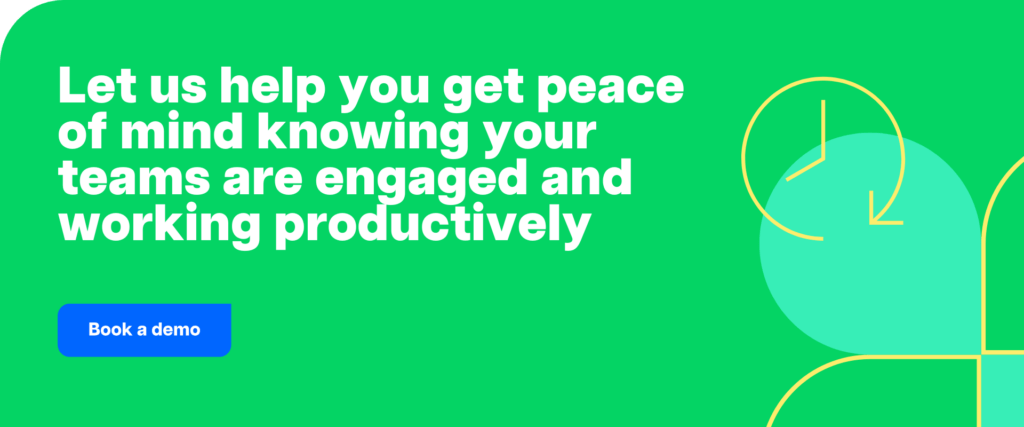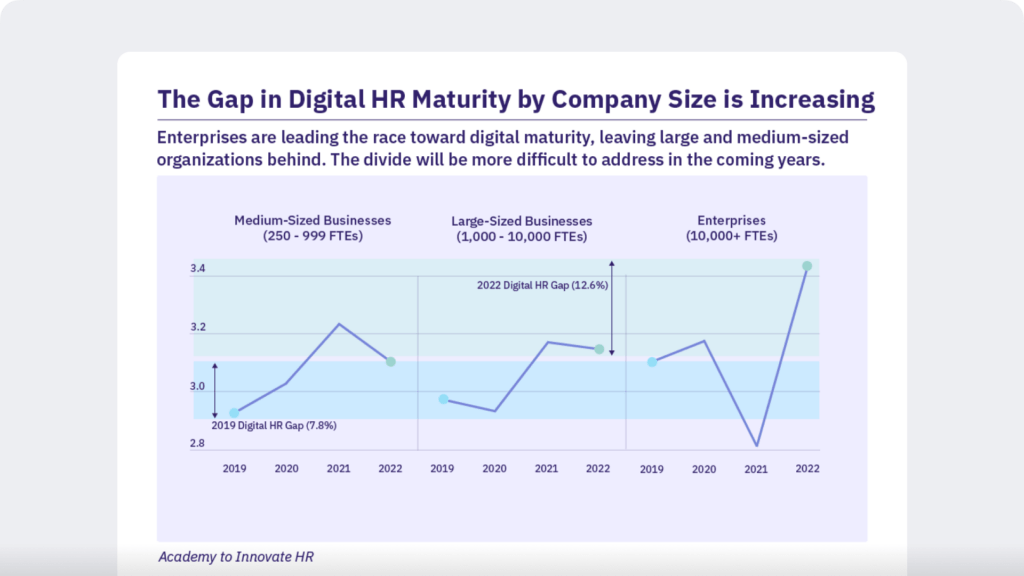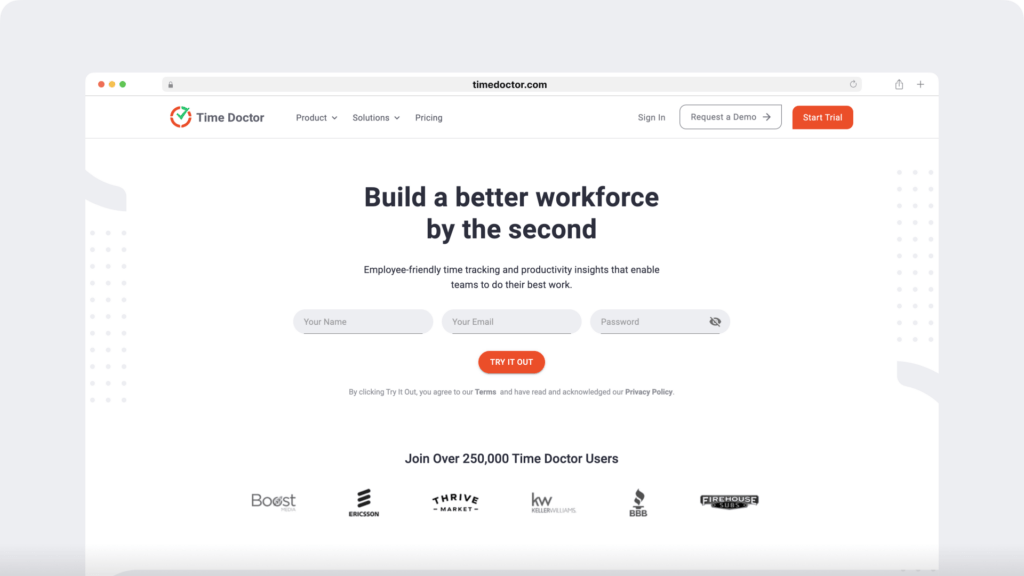Work is evolving. HR is evolving. Employee demands are evolving.
In a world of work where nothing seems static, everything is new, and everyone is exhausted, HR technology can feel like one too many plates to keep spinning.
That could explain why the data around HR tech says that practitioners are adopting an attitude of “don’t fix what isn’t broken” while the gap widens between capability and expectation.
Let’s explain what we mean.
In a four-year study, the Academy to Innovate HR (AIHR) found the pandemic accelerated digital HR maturity by at least seven years. Their report says that before the pandemic, 49% of organizations agreed digital was a key objective in their people strategy. By the end of 2022, that had increased to 63%.
On the flip side, Gartner’s survey of 500+ HR leaders found that 60% were uncertain what impact evolving trends like generative AI would have, while 56% felt their current tech solutions and strategy weren’t meeting the mark.
Table of Contents
- Why HR technology is evolving at a rapid rate
- HR technology in practice: Finding, hiring and supporting the best people
- Why technology is a strategic priority, not just another HR trend
- Creating a strategic digital vision
- Why HR technology adoption has fallen behind
- Time Doctor is your partner in HR technology transformation
Why HR technology is evolving at a rapid rate
It’s impossible to separate HR tech from the evolution of the role and the global shift to hybrid work. Within the next 12 months, we expect to see the function evolve from process-driven to people-focused and strategic.
Part of that evolution is “HR” restyling to “People and Culture”. Read our latest blog on 2024 HR trends to find out what’s in a name and what else to expect.
We’ll use both names interchangeably when referring to technology, because most people are familiar with “HR tech”.
This evolution brings new opportunities in employee engagement, productivity and reporting. New technologies – and the inevitable transition to hybrid working – also present challenges for People and Culture teams, such as generating responsible use guidelines, maintaining cultural connections in hybrid workplaces, and managing machines alongside people.
Granted, many of the benefits of technology (and the risks of misuse) apply to employees, C-suites and profit margins. We’re only looking at the impact of technology designed for HR functions and owned by HR teams.

HR technology in practice: Finding, hiring and supporting the best people
If it seems like good people are hard to find, it’s because they are. Randstad, a name any People and Culture professional will know, called the current labor shortage “one of the biggest challenges in modern history”.
As much as 59% of the workforce is disengaged, and more than half (51%) are looking for a new role.
As millions of lucrative positions remain unfilled and skilled people job-hop more than ever, People and Culture managers are turning to new technologies for help finding candidates, engaging employees and preventing turnover.
Talent acquisition
1. Applicant tracking systems (ATS)
ATS software scales recruiting and hiring capabilities, coordinating job postings and applications across multiple platforms. The system will organize candidate data, making it searchable to increase efficiency and find the best people.
2. AI-powered sourcing
Algorithms scour the global talent pool, analyzing LinkedIn profiles and resumes to identify candidates with the right skills. There are also automated outreach tools to attract more people, and chatbots that answer candidate questions.
3. Video interviews
Virtual interview platforms save time by automating remote screening and evaluation. There’s a big trend towards asynchronous video interviewing, with the next logical step being AI features that summarize and analyze interviewee responses.
Employee engagement
1. Feedback tools
Pulse surveys are improving, enabling People and Culture to conduct multi-dimensional mood checks. However, formal feedback is fraught; most employees don’t trust that anonymous surveys are actually anonymous.
2. People analytics
The advantage of workday analytics software is the breadth and depth of data at your fingertips. And, unlike pulse surveys, workday data is unbiased. If you know which metrics correlate to employee engagement, software like Time Doctor makes it easier to keep your finger on the pulse and boost employee engagement.
For example, our Work-Life Balance widget alerts administrators and managers to potential burnout issues before they go boom. In addition, you can track engagement signals like unscheduled breaks, distractions, and schedule adherence to identify and re-engage frustrated employees.
3. Mobile apps
Employee apps provide self-service features to access work-related information, request time off, receive updates and manage schedules, enhancing experience while reducing HR’s admin load.
4. Recognition platforms
Less than one in three US employees receives recognition for a job well done. Recognition and rewards platforms aim to reverse this trend through peer-to-peer recognition and manager rewards systems.
We expect to see more integrations between people analytics and recognition platforms in the future, enabling micro-rewards programs, automated alerts for managers, and a swathe of engagement-boosting initiatives to motivate hybrid teams.
5. Learning Management Systems (LMS)
LMS platforms offer a wide range of courses and resources for self-guided skill development, giving employees agency and boosting engagement. You can also use an LMS to gamify mandatory training, making it more engaging for employees.
Retention and turnover
1. Predictive analytics
Cutting-edge HR tech can predict attrition risks by analyzing workday data and identifying patterns of employees likely to leave. This allows People and Culture to proactively address retention issues, in many cases even before the employee knows they want to quit.
2. Performance management
Feedback systems tied into people analytics software allow employees to self-manage performance and productivity, encouraging accountability and enabling hybrid schedules. When just 32% of US managers are proactive about progress, it’s easy for employees to feel stuck in a rut. Giving employees tools to assess and monitor their growth has also been shown to boost engagement.
3. Employee well-being
Anywhere from 25% to 75% of employees are experiencing burnout symptoms. Monitoring well-being data, such as unscheduled overtime, weekend work, late hours and long days, helps managers work with HR to intervene early and support employees at risk of exhaustion.
Why technology is a strategic priority, not just another HR trend
HR technology touches virtually every part of the evolved role, offering much more than process improvements.
- Efficiency: Automating administrative tasks saves time and resources.
- Data-driven decisions: Technology provides insights for workforce planning and strategy.
- Improved recruitment: AI and analytics help identify and attract top talent more effectively.
- Hybrid work: HR tech like people analytics removes the barriers and blind spots that hold organizations back from embracing hybrid working.
- Proving effectiveness: Workday data helps People and Culture generate reports and track KPIs for C-suites under pressure to deliver growth.
- Enhanced employee experience: Tools like self-service portals and mobile apps give employees agency.
- Compliance and security: Technology helps maintain accurate, secure records and ensures compliance with regulations.
- Talent development: Learning platforms support skills development and help HR identify capability gaps.
- Engagement and retention: Data analytics can pinpoint issues and support retention strategies.
- Global reach: HR tech facilitates international talent acquisition.
The bottom line is that technology plays a pivotal role in attracting, retaining and upskilling good people. Exactly how depends on matching your needs with the right solutions and making targeted investments that move the needle on organizational KPIs.
Creating a strategic digital vision
In our recent in-depth guide to HR trends and priorities, we discussed the need for a new strategic vision that reflects HR’s evolution into People and Culture. As we leave process-driven HR in the past and move towards people-focused People and Culture, this strategic vision defines how the function sees itself and is seen by the organization.
Get the new guide, Breaking down HR’s top priorities in 2024, to learn more about emerging HR trends, plus access resources to transform your team’s capabilities.

Technology is a big part of that new vision. Firstly, within People and Culture as a productivity enabler, insight deliverer and engagement enhancer – this is the area we’re focused on.
Secondly, there is also People and Culture’s remit in adopting technology like generative AI and automation tools. This is a (very big and very dense) topic for another time.
HR technology comes into the vision in supporting People and Culture to achieve redefined strategic goals. This will look different for every organization, so there is no hard and fast rule about which technology to adopt first.
For example, People and Culture in a BPO struggling to hire enough high-performing call center agents might prioritize an applicant tracking system paired with people analytics to ensure current employees have the support they need.
Then again, a growing eCommerce brand would definitely want to prioritize people analytics to maintain oversight of a growing (and increasingly globally diverse) workforce.
Overlaying all this is the seemingly endless sprawl of the People and Culture tech landscape. There are dozens of standalone solutions in each category, as well as integrated platforms that perform multiple functions.
To help plan and prioritize your 2024 evolution, we’ve developed a framework for evaluating HR tech.
Identify
Start by defining your team’s specific needs, challenges and opportunities. You will find these at the intersection of organizational growth goals and People and Culture strategic priorities.
Don’t worry if the goals are vague at this stage. You will have an opportunity later to distill them into measurable KPIs. For now, you are translating your new strategic vision into aspirations.
Investigate
Do your research. Once you have identified your needs, research different solutions to see which type of tool best fits your organization both now and in the aspirational future state.
Consider all the combinations: standalone solutions, integrated platforms, cross-platform integrations and the latent capacity in existing technology. After analyzing existing platforms, you might find the leap from here to there is shorter than you’d first thought.
With your longlist of platforms whittled to a shortlist, reach out to vendors for a demonstration. This is the best way to assess the fit, features and future growth capacity.
Incentivize
Get buy-in from key stakeholders before implementing any new technology. Ideally, this would look like consultation with managers, executives and employees to design a tech stack that suits everyone.
Communicating the purpose for technology change early, often and consistently helps ensure the technology is adopted and used effectively.
Implement
Once you have implemented a new HR technology platform, it’s important to provide training and support to people in your team and any employees who will interact with it.
Continue communicating throughout this process. Be transparent about use cases, successes and challenges, always remembering to frame your journey in the context of organizational momentum.
Why HR technology adoption has fallen behind
It would be unfair to say that a lack of strategic vision is the only reason People and Culture tech adoption goes awry. There’s a lot more to it.
AIHR data shows that enterprise businesses with over 10k employees are adopting HR tech at nearly double the rate of medium businesses (250-999 people) and 2.1x the rate of large firms (1k to 10k).

Medium and large firms haven’t fallen behind due to lack of agility, vision or desire. It’s more likely that HR technology transformation fell down the priority list during the pandemic. A series of budgetary and bureaucratic barriers are now in the way.
1. Compliance and data privacy
People and Culture handles sensitive employee data. Compliance with data protection laws can be a significant hurdle when implementing new technologies.
Solution: Blockchain technology is becoming a popular way to store and manage data, thanks to the baked-in security.
2. Change management
Resistance to change is common. Communication, training and support will help build organizational support.
Solution: Use our framework to prioritize HR tech adoption in alignment with organizational goals. Involve stakeholders at every level and communicate the aims clearly from day one.
3. Budget constraints
Acquiring and implementing new HR technologies can be expensive. As well as subscription and service charges, there’s the time and training investment to consider.
Solution: Assess existing systems to see if you can remove barriers and access latent capacity. Before investing in new technology, build a rock-solid business case that links employee outcomes to organizational targets.
4. Integration with legacy systems
Many People and Culture departments inherit old systems or work in strict IT environments, making it difficult to integrate new technologies seamlessly.
Solution: Look for upgrades, extensions and integrations. Failing that, make a plan to roll old processes into new streamlined systems.
5. Skills gap
As HR evolves into People and Culture, there may be a learning curve to leverage emerging technologies effectively. This goes for employees, managers and C-suites as well.
Solution: Build in time for training and transition. Work with software vendors to implement the tech gradually, ensuring key users become champions.
Time Doctor is your partner in HR technology transformation

As a cornerstone of the HR technology landscape, people analytics is often the first priority for technological transformation.
Time Doctor is a demonstrated leader in the space. Our employee-friendly time tracking and productivity insights enable People and Culture leaders to build a better workforce by the second.
We’re helping organizations evolve by enabling teams to do their best work. Learn more about Time Doctor’s features or request a 1:1 demonstration.

Andy is a technology & marketing leader who has delivered award-winning and world-first experiences.


